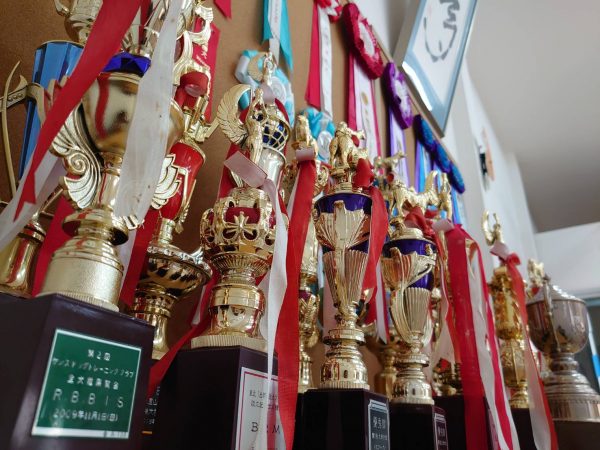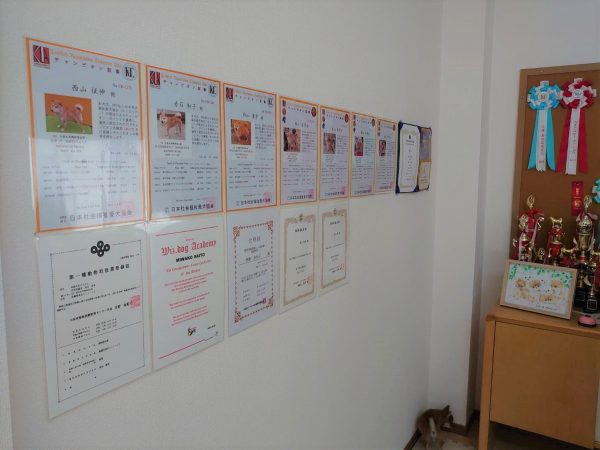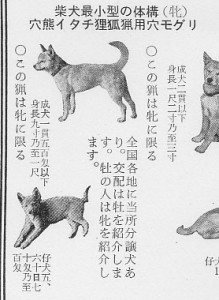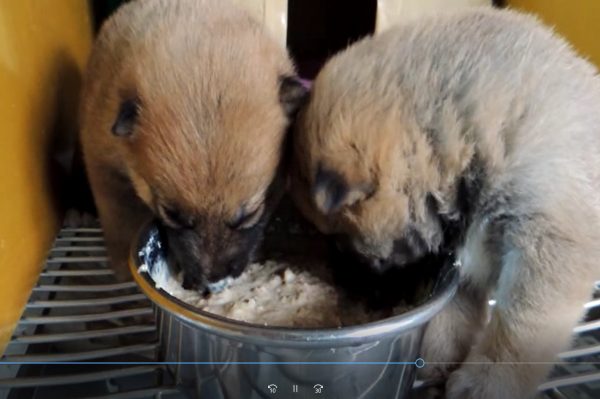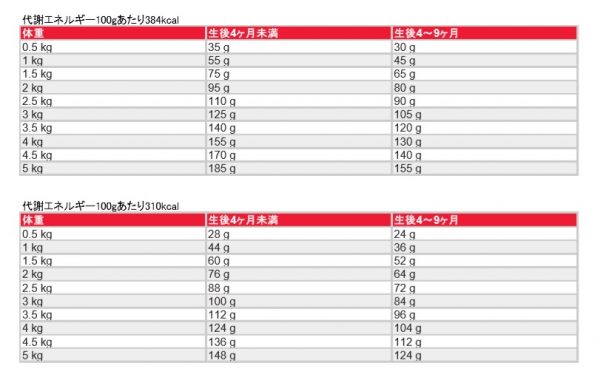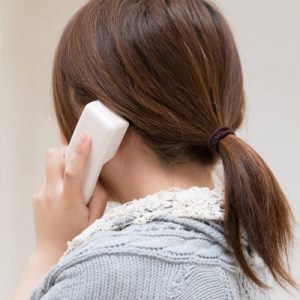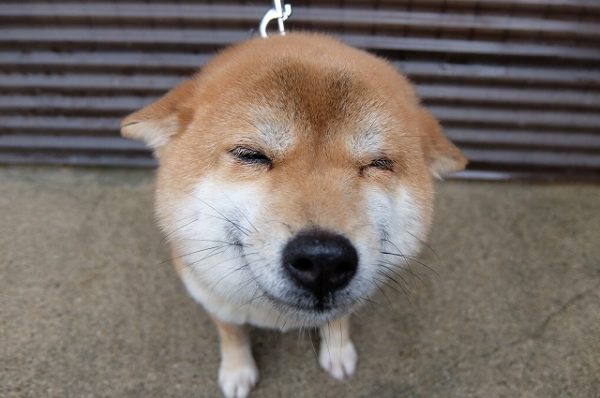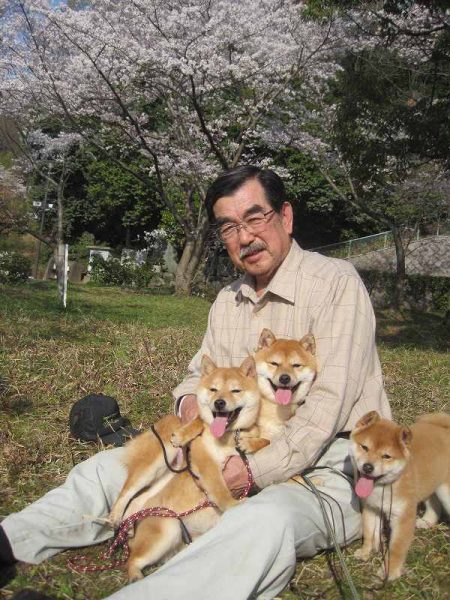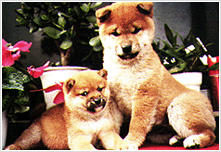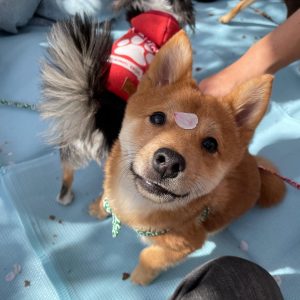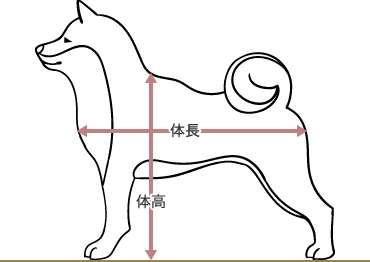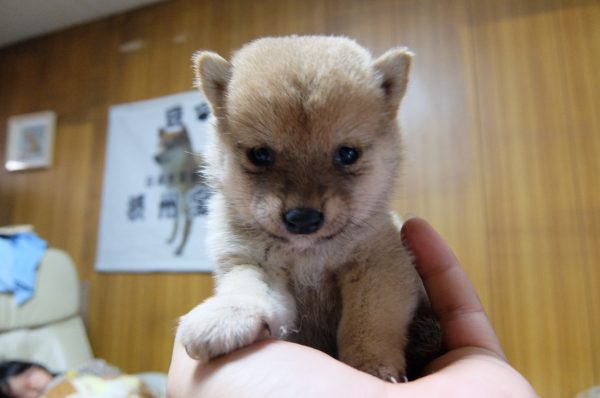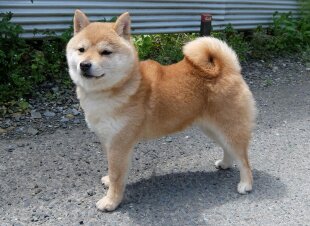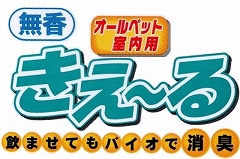Japan’s oldest Mameshiba Inu kennel
| Sesshu Hozanso, the longest-established kennel specializing in Mameshiba in Japan, welcomes customers from all over the world. |
 |
|
|
| Click to see the Google review. |
|
CONTENTS. Japan’s oldest Mameshiba Inu kennel
|
| Thank you for being interested in Mameshiba Inu. |
| You are very lucky to have found your way here. |
| This is the oldest kennel specializing in Mameshiba in Japan. |
| The excellent full-time dog trainer has extensive international experience and speaks English. |
| We have a lot of experience in exporting puppies overseas, and we can help you do what we can do in Japan to take your puppy overseas. |
Watch out for fakes. |
| Despite the country of origin of the Mameshiba, there are a very large number of fakes mixed in with Mameshiba Inus sold in Japan. |
| In 2008, the fixation of the Mameshiba dog of our kennel “Sesshu Hozanso” lineage was approved, and the pedigree of the new breed “Mameshiba Inu” was issued for the first time in the world. |
| Until now, 2023, we have continued to earnestly breed the “Mameshiba Inu” without cheating and have won public recognition, even though we have been bitterly attacked by other associations who do not recognize the “Mameshiba Inu”. |
Mame(Bean)-type Shiba Inu at pet stores. |
| As Shiba Inus became less sellable and the popularity of Mameshiba Inus increased, our waiting list for Mameshiba Inu puppies increased, and the waiting list became two to three years long. |
| (As of 2023, there is a wait time ranging from a few weeks to several months. Please ask for the latest information by email.) |
| Pet stores caught on to this and began selling Shiba Inus, labeling them as “Mameshiba-type” or “Mameshiba-size“. |
| They are not Mameshiba, but they are smaller than Shiba Inus and selling hard-to-sell Shiba Inus as if they were Mameshiba has become a problem. |
| “If you want to get a puppy from Hozanso, the most famous Mameshiba kennel, you have to wait for years, but you can get this one right away!” is the pet store’s sales pitch. |
|
When pet stores sell a dog with a pedigree from Nihonken Hozonkai, they sell it under the trade name “Mameshiba,” but the breed is not “Mameshiba”. |
|
The Nihonken Hozonkai does not recognize the “Mameshiba” as a dog breed, so a pedigree is issued as a “Shiba Inu”. |
|
It is not a Mameshiba, so if you are asking if it is a Mameshiba, no. It means it is a fake. |
Shiba Inu? Mameshiba Inu? |
| “Shiba Inus do not sell well, Mameshiba Inus sell better and for a higher price.” |
| Shiba breeders have taken notice of this and are selling them under the name “Mameshiba Inu”. |
| Unfortunately, the Japanese dog industry does not apply the idea that Japanese people are honest and would not cheat. |
| Like many Japanese, people overseas have probably never seen a real Mameshiba Inu. |
| If you have never seen a real Mameshiba, you will believe that it is a Mameshiba when you are shown a Shiba Inu and told, “It’s a Mameshiba!” |
| When he grows up, you don’t realize you are fooled because there are no Mameshiba Inu in your neighborhood to compare it to. |
| The price of a Mameshiba is almost double that of a Shiba Inu. |
| For that much money you can buy a very good Shiba Inu puppy. |
| What are you here for? |
| Shiba Inu? Mameshiba Inu? |
Can you give up your dog? |
| Even Japanese people are fooled into thinking a Shiba Inu is a Mameshibai Inu, buy a Shiba Inu at an expensive price, and realize after the Shiba Inu grows up that they were fooled! |
| Under Japanese law, if you sue for your refund, you will be told to “return the dog”. |
| But they cannot simply give up their dog just because their dog has grown up after spending a year with them. |
| They will not return the dog so they cannot get a refund. |
| It just means that they bought a Shiba Inu at a high price. |
| This is because it is not a crime to sell a Shiba Inu labeled as a Mameshiba Inu. |
| The breed is Shiba Inu, called Mameshiba Inu. |
| Our kennel’s dog breed is “Mame-Shiba Inu”, also called “Mameshiba Inu”. |
Eat well and still small. This is the real Mameshiba! |
| In Japan today, it is very important to choose the right kennel. |
| Mame-Shiba Inus are one size smaller than Shiba Inus. This is the general impression of Mameshiba. |
| Therefore, breeders who sell Shiba as Mameshiba instruct their customers to “feed them less” so that they will not receive complaints that “the dog has grown too big!” |
| Such dogs are forced to restrict their diet from puppyhood, so they may not grow large. |
| Even a Shiba Inu could be stopped at Mameshiba size growth if not fed. |
| But it is a Shiba Inu, not a Mameshiba. |
| Eat well and still small. This is the real Mameshiba. |
To preserve the unique culture of Japan, participate in exhibitions and win many titles. |
| Shiba Inus are loved by people all over the world because they are natural purebreds that have not been manipulated by humans. |
| Exhibitions are held to prevent breeders from modifying them as they wish, and to maintain the form that will be preserved for future generations as part of Japan’s unique culture. |
| Winning a title at an exhibition is an important role in keeping the Shiba Inu purely as a part of Japanese culture for future generations. |
Most title winner in Japan
|
| We are the only kennel that has or has had Mameshiba winning championship titles in all breeds. |
|
Even if other Mameshiba breeders participate in exhibitions, they are not evaluated. |
|
Mameshiba, which are made small by force without feeding, cannot win in the exhibition of all breeds where the best breeders gather. |
| Our kennel is a most Mameshiba Champion title holder in Japan. |
| As a result of our long and devoted efforts, we were the first kennel in the world to have the breed “Mameshiba inu” recognized by the KC Japan. |
| The first Mameshiba to be awarded the championship in KC Japan was also our kennel’s dog, Kuu. |
|
champion title certificate
|
New Association to protect Mameshiba |
| KC Japan was the first in the world to approve the Mameshiba breed, but in an attempt to increase the number of members, it made the foolish mistake of allowing the registration of dogs that were crossbred with Shiba and Mameshiba dogs, which quickly let to the mass production of oversized Mameshiba dogs. |
| As a result, a series of people have been affected by the problems: they bought a Mameshiba Inu, but it grew to be as large as a Shiba Inu. |
| People who were concerned about the future of the Mameshiba breed gathered together as they believed that the breed would indeed be devoured if the situation continued as is, and formed a new association, the “Nihon Mame Shiba Ken Kyokai (Japan Mame Shiba Dog Association, NMSA)”. |
| In the NMSA, a dog could be a “Mameshiba Inu” only if it has the “Hozanso (our kennel) lineage” in its blood. |
| If the ancestor dog is not from our kennel, it is not recognized as a Mameshiba. |
| Both the world’s first association (KCJ) to issue a pedigree of Mameshiba and the new association, NMSA set the first requirement to become a “Mameshiba inu” as being of the Hozanso lineage. |
| Furthermore, both associations have adopted the Mameshiba standards that our kennel has developed. |
| And the first champion holder of both KCJ and NMSA was our Mameshiba. |
A kennel with an outstanding history and a proven record of success. |
| No other kennel in the world has such an outstanding history and a proven record of success. |
| After building trust over time, “Mameshiba Inu” was finally recognized in Japan. |
| However, the number of unethical breeders and puppy mills that take advantage of our efforts for free has increased dramatically, and even Japanese people are being defrauded. |
| There are many breeders who specialize in making money with good advertising, but the kennel you are visiting has the longest history in Japan regarding Mameshiba Inu, was the first in Japan to obtain the breed “Mameshiba Inu”, was the first in Japan to produce Mameshiba Champion Dogs, and holds the most Champion Mameshibas in Japan! |
| And it is the kennel that produced the ancestral dog that has the bloodline of “Hozanso,” which is the condition to become a Mameshiba. |
| We are an ethical and loving breeder and a genuine kennel specializing in Mameshiba, and even give out puppies with “potty training, no sweet-biting behavior, and obedience to be held” before they go to homes. |
| There is no other Mameshiba kennel with a history of more than half a century like our kennel. |
| We are good owners to our mother dogs. |
| We are obstetricians and gynecologists when mothers carry their litters. |
| We are midwives when mothers give birth to their litters. |
| We are the nurserymen when puppies are born. |
| We are the puppies’ teachers and friends once they have left their mother’s den. |
| We are good caregivers to our retired, old dogs. |
| We are good advisors to our new owners. |
| That is our kennel policy. |
| Japan’s oldest mameshiba Inu kennel |
| What is a Mameshiba Inu |
| Mameshiba Inu Information |
| Purchase a Mameshiba Inu |
| FAQs about Export and Mameshiba Inu |
| Terms and conditions of the contract for the sale of living organisms |
| Appropriate amount of food for the Mameshiba |
| Preparation for Acceptance (Training) |
| Basic Knowledge of the Mameshiba Inu |
|
To visit our dog kennel, a reservation is required. Click here to make a reservation. You can make a reservation by contacting us at the following address: 豆柴の里・摂州宝山荘 |
| Sesshu Hozanso, the longest-established kennel specializing in Mameshiba in Japan, welcomes customers from all over the world. |
 |
|
|
| Click to see the Google review. |
|
CONTENTS. Japan’s oldest Mameshiba Inu kennel
|
| Thank you for being interested in Mameshiba Inu. |
| You are very lucky to have found your way here. |
| This is the oldest kennel specializing in Mameshiba in Japan. |
| The excellent full-time dog trainer has extensive international experience and speaks English. |
| We have a lot of experience in exporting puppies overseas, and we can help you do what we can do in Japan to take your puppy overseas. |
Watch out for fakes. |
| Despite the country of origin of the Mameshiba, there are a very large number of fakes mixed in with Mameshiba Inus sold in Japan. |
| In 2008, the fixation of the Mameshiba dog of our kennel “Sesshu Hozanso” lineage was approved, and the pedigree of the new breed “Mameshiba Inu” was issued for the first time in the world. |
| Until now, 2023, we have continued to earnestly breed the “Mameshiba Inu” without cheating and have won public recognition, even though we have been bitterly attacked by other associations who do not recognize the “Mameshiba Inu”. |
Mame(Bean)-type Shiba Inu at pet stores. |
| As Shiba Inus became less sellable and the popularity of Mameshiba Inus increased, our waiting list for Mameshiba Inu puppies increased, and the waiting list became two to three years long. |
| (As of 2023, there is a wait time ranging from a few weeks to several months. Please ask for the latest information by email.) |
| Pet stores caught on to this and began selling Shiba Inus, labeling them as “Mameshiba-type” or “Mameshiba-size“. |
| They are not Mameshiba, but they are smaller than Shiba Inus and selling hard-to-sell Shiba Inus as if they were Mameshiba has become a problem. |
| “If you want to get a puppy from Hozanso, the most famous Mameshiba kennel, you have to wait for years, but you can get this one right away!” is the pet store’s sales pitch. |
|
When pet stores sell a dog with a pedigree from Nihonken Hozonkai, they sell it under the trade name “Mameshiba,” but the breed is not “Mameshiba”. |
|
The Nihonken Hozonkai does not recognize the “Mameshiba” as a dog breed, so a pedigree is issued as a “Shiba Inu”. |
|
It is not a Mameshiba, so if you are asking if it is a Mameshiba, no. It means it is a fake. |
Shiba Inu? Mameshiba Inu? |
| “Shiba Inus do not sell well, Mameshiba Inus sell better and for a higher price.” |
| Shiba breeders have taken notice of this and are selling them under the name “Mameshiba Inu”. |
| Unfortunately, the Japanese dog industry does not apply the idea that Japanese people are honest and would not cheat. |
| Like many Japanese, people overseas have probably never seen a real Mameshiba Inu. |
| If you have never seen a real Mameshiba, you will believe that it is a Mameshiba when you are shown a Shiba Inu and told, “It’s a Mameshiba!” |
| When he grows up, you don’t realize you are fooled because there are no Mameshiba Inu in your neighborhood to compare it to. |
| The price of a Mameshiba is almost double that of a Shiba Inu. |
| For that much money you can buy a very good Shiba Inu puppy. |
| What are you here for? |
| Shiba Inu? Mameshiba Inu? |
Can you give up your dog? |
| Even Japanese people are fooled into thinking a Shiba Inu is a Mameshibai Inu, buy a Shiba Inu at an expensive price, and realize after the Shiba Inu grows up that they were fooled! |
| Under Japanese law, if you sue for your refund, you will be told to “return the dog”. |
| But they cannot simply give up their dog just because their dog has grown up after spending a year with them. |
| They will not return the dog so they cannot get a refund. |
| It just means that they bought a Shiba Inu at a high price. |
| This is because it is not a crime to sell a Shiba Inu labeled as a Mameshiba Inu. |
| The breed is Shiba Inu, called Mameshiba Inu. |
| Our kennel’s dog breed is “Mame-Shiba Inu”, also called “Mameshiba Inu”. |
In Japan today, it is very important to choose the right kennel.Eat well and still small. This is the real Mameshiba! |
|
Mame-Shiba Inus are one size smaller than Shiba Inus. This is the general impression of Mameshiba. |
| Therefore, breeders who sell Shiba as Mameshiba instruct their customers to “feed them less” so that they will not receive complaints that “the dog has grown too big!” |
| Such dogs are forced to restrict their diet from puppyhood, so they may not grow large. |
| Even a Shiba Inu could be stopped at Mameshiba size growth if not fed. |
| But it is a Shiba Inu, not a Mameshiba. |
| Eat well and still small. This is the real Mameshiba. |
To preserve the unique culture of Japan,participate in exhibitions and win many titles. |
| Shiba Inus are loved by people all over the world because they are natural purebreds that have not been manipulated by humans. |
| Exhibitions are held to prevent breeders from modifying them as they wish, and to maintain the form that will be preserved for future generations as part of Japan’s unique culture. |
| Winning a title at an exhibition is an important role in keeping the Shiba Inu purely as a part of Japanese culture for future generations. |
Most title winner in Japan
|
| We are the only kennel that has or has had Mameshiba winning championship titles in all breeds. |
|
Even if other Mameshiba breeders participate in exhibitions, they are not evaluated. |
|
Mameshiba, which are made small by force without feeding, cannot win in the exhibition of all breeds where the best breeders gather. |
| Our kennel is a most Mameshiba Champion title holder in Japan. |
| As a result of our long and devoted efforts, we were the first kennel in the world to have the breed “Mameshiba inu” recognized by the KC Japan. |
| The first Mameshiba to be awarded the championship in KC Japan was also our kennel’s dog, Kuu. |
|
champion title certificate
|
New Association to protect Mameshiba |
| KC Japan was the first in the world to approve the Mameshiba breed, but in an attempt to increase the number of members, it made the foolish mistake of allowing the registration of dogs that were crossbred with Shiba and Mameshiba dogs, which quickly let to the mass production of oversized Mameshiba dogs. |
| As a result, a series of people have been affected by the problems: they bought a Mameshiba Inu, but it grew to be as large as a Shiba Inu. |
| People who were concerned about the future of the Mameshiba breed gathered together as they believed that the breed would indeed be devoured if the situation continued as is, and formed a new association, the “Nihon Mame Shiba Ken Kyokai (Japan Mame Shiba Dog Association, NMSA)”. |
| In the NMSA, a dog could be a “Mameshiba Inu” only if it has the “Hozanso (our kennel) lineage” in its blood. |
| If the ancestor dog is not from our kennel, it is not recognized as a Mameshiba. |
| Both the world’s first association (KCJ) to issue a pedigree of Mameshiba and the new association, NMSA set the first requirement to become a “Mameshiba inu” as being of the Hozanso lineage. |
| Furthermore, both associations have adopted the Mameshiba standards that our kennel has developed. |
| And the first champion holder of both KCJ and NMSA was our Mameshiba. |
A kennel with an outstanding history and a proven record of success. |
| No other kennel in the world has such an outstanding history and a proven record of success. |
| After building trust over time, “Mameshiba Inu” was finally recognized in Japan. |
| However, the number of unethical breeders and puppy mills that take advantage of our efforts for free has increased dramatically, and even Japanese people are being defrauded. |
| There are many breeders who specialize in making money with good advertising, but the kennel you are visiting has the longest history in Japan regarding Mameshiba Inu, was the first in Japan to obtain the breed “Mameshiba Inu”, was the first in Japan to produce Mameshiba Champion Dogs, and holds the most Champion Mameshibas in Japan! |
| And it is the kennel that produced the ancestral dog that has the bloodline of “Hozanso,” which is the condition to become a Mameshiba. |
| We are an ethical and loving breeder and a genuine kennel specializing in Mameshiba, and even give out puppies with “potty training, no sweet-biting behavior, and obedience to be held” before they go to homes. |
| There is no other Mameshiba kennel with a history of more than half a century like our kennel. |
| We are good owners to our mother dogs. |
| We are obstetricians and gynecologists when mothers carry their litters. |
| We are midwives when mothers give birth to their litters. |
| We are the nurserymen when puppies are born. |
| We are the puppies’ teachers and friends once they have left their mother’s den. |
| We are good caregivers to our retired, old dogs. |
| We are good advisors to our new owners. |
| That is our kennel policy. |
| Japan’s oldest mameshiba Inu kennel |
| What is a Mameshiba Inu |
| Mameshiba Inu Information |
| Purchase a Mameshiba Inu |
| FAQs about Export and Mameshiba Inu |
| Terms and conditions of the contract for the sale of living organisms |
| Appropriate amount of food for the Mameshiba |
| Preparation for Acceptance (Training) |
| Basic Knowledge of the Mameshiba Inu |
|
To visit our dog kennel, a reservation is required. Click here to make a reservation. You can make a reservation by contacting us at the following address: 豆柴の里・摂州宝山荘 |
| Sesshu Hozanso, the longest-established kennel specializing in Mameshiba in Japan, welcomes customers from all over the world. |
 |
|
|
| Click to see the Google review. |
|
CONTENTS. Japan’s oldest Mameshiba Inu kennel
|
| Thank you for being interested in Mameshiba Inu. |
| You are very lucky to have found your way here. |
| This is the oldest kennel specializing in Mameshiba in Japan. |
| The excellent full-time dog trainer has extensive international experience and speaks English. |
| We have a lot of experience in exporting puppies overseas, and we can help you do what we can do in Japan to take your puppy overseas. |
Watch out for fakes. |
| Despite the country of origin of the Mameshiba, there are a very large number of fakes mixed in with Mameshiba Inus sold in Japan. |
| In 2008, the fixation of the Mameshiba dog of our kennel “Sesshu Hozanso” lineage was approved, and the pedigree of the new breed “Mameshiba Inu” was issued for the first time in the world. |
| Until now, 2023, we have continued to earnestly breed the “Mameshiba Inu” without cheating and have won public recognition, even though we have been bitterly attacked by other associations who do not recognize the “Mameshiba Inu”. |
Mame(Bean)-type Shiba Inu at pet stores. |
| As Shiba Inus became less sellable and the popularity of Mameshiba Inus increased, our waiting list for Mameshiba Inu puppies increased, and the waiting list became two to three years long. |
| (As of 2023, there is a wait time ranging from a few weeks to several months. Please ask for the latest information by email.) |
| Pet stores caught on to this and began selling Shiba Inus, labeling them as “Mameshiba-type” or “Mameshiba-size“. |
| They are not Mameshiba, but they are smaller than Shiba Inus and selling hard-to-sell Shiba Inus as if they were Mameshiba has become a problem. |
| “If you want to get a puppy from Hozanso, the most famous Mameshiba kennel, you have to wait for years, but you can get this one right away!” is the pet store’s sales pitch. |
|
When pet stores sell a dog with a pedigree from Nihonken Hozonkai, they sell it under the trade name “Mameshiba,” but the breed is not “Mameshiba”. |
|
The Nihonken Hozonkai does not recognize the “Mameshiba” as a dog breed, so a pedigree is issued as a “Shiba Inu”. |
|
It is not a Mameshiba, so if you are asking if it is a Mameshiba, no. It means it is a fake. |
Shiba Inu? Mameshiba Inu? |
| “Shiba Inus do not sell well, Mameshiba Inus sell better and for a higher price.” |
| Shiba breeders have taken notice of this and are selling them under the name “Mameshiba Inu”. |
| Unfortunately, the Japanese dog industry does not apply the idea that Japanese people are honest and would not cheat. |
| Like many Japanese, people overseas have probably never seen a real Mameshiba Inu. |
| If you have never seen a real Mameshiba, you will believe that it is a Mameshiba when you are shown a Shiba Inu and told, “It’s a Mameshiba!” |
| When he grows up, you don’t realize you are fooled because there are no Mameshiba Inu in your neighborhood to compare it to. |
| The price of a Mameshiba is almost double that of a Shiba Inu. |
| For that much money you can buy a very good Shiba Inu puppy. |
| What are you here for? |
| Shiba Inu? Mameshiba Inu? |
Can you give up your dog? |
| Even Japanese people are fooled into thinking a Shiba Inu is a Mameshibai Inu, buy a Shiba Inu at an expensive price, and realize after the Shiba Inu grows up that they were fooled! |
| Under Japanese law, if you sue for your refund, you will be told to “return the dog”. |
| But they cannot simply give up their dog just because their dog has grown up after spending a year with them. |
| They will not return the dog so they cannot get a refund. |
| It just means that they bought a Shiba Inu at a high price. |
| This is because it is not a crime to sell a Shiba Inu labeled as a Mameshiba Inu. |
| The breed is Shiba Inu, called Mameshiba Inu. |
| Our kennel’s dog breed is “Mame-Shiba Inu”, also called “Mameshiba Inu”. |
In Japan today, it is very important to choose the right kennel.Eat well and still small. This is the real Mameshiba! |
|
Mame-Shiba Inus are one size smaller than Shiba Inus. This is the general impression of Mameshiba. |
| Therefore, breeders who sell Shiba as Mameshiba instruct their customers to “feed them less” so that they will not receive complaints that “the dog has grown too big!” |
| Such dogs are forced to restrict their diet from puppyhood, so they may not grow large. |
| Even a Shiba Inu could be stopped at Mameshiba size growth if not fed. |
| But it is a Shiba Inu, not a Mameshiba. |
| Eat well and still small. This is the real Mameshiba. |
To preserve the unique culture of Japan,participate in exhibitions and win many titles. |
| Shiba Inus are loved by people all over the world because they are natural purebreds that have not been manipulated by humans. |
| Exhibitions are held to prevent breeders from modifying them as they wish, and to maintain the form that will be preserved for future generations as part of Japan’s unique culture. |
| Winning a title at an exhibition is an important role in keeping the Shiba Inu purely as a part of Japanese culture for future generations. |
Most title winner in Japan
|
| We are the only kennel that has or has had Mameshiba winning championship titles in all breeds. |
|
Even if other Mameshiba breeders participate in exhibitions, they are not evaluated. |
|
Mameshiba, which are made small by force without feeding, cannot win in the exhibition of all breeds where the best breeders gather. |
| Our kennel is a most Mameshiba Champion title holder in Japan. |
| As a result of our long and devoted efforts, we were the first kennel in the world to have the breed “Mameshiba inu” recognized by the KC Japan. |
| The first Mameshiba to be awarded the championship in KC Japan was also our kennel’s dog, Kuu. |
|
champion title certificate
|
New Association to protect Mameshiba |
| KC Japan was the first in the world to approve the Mameshiba breed, but in an attempt to increase the number of members, it made the foolish mistake of allowing the registration of dogs that were crossbred with Shiba and Mameshiba dogs, which quickly let to the mass production of oversized Mameshiba dogs. |
| As a result, a series of people have been affected by the problems: they bought a Mameshiba Inu, but it grew to be as large as a Shiba Inu. |
| People who were concerned about the future of the Mameshiba breed gathered together as they believed that the breed would indeed be devoured if the situation continued as is, and formed a new association, the “Nihon Mame Shiba Ken Kyokai (Japan Mame Shiba Dog Association, NMSA)”. |
| In the NMSA, a dog could be a “Mameshiba Inu” only if it has the “Hozanso (our kennel) lineage” in its blood. |
| If the ancestor dog is not from our kennel, it is not recognized as a Mameshiba. |
| Both the world’s first association (KCJ) to issue a pedigree of Mameshiba and the new association, NMSA set the first requirement to become a “Mameshiba inu” as being of the Hozanso lineage. |
| Furthermore, both associations have adopted the Mameshiba standards that our kennel has developed. |
| And the first champion holder of both KCJ and NMSA was our Mameshiba. |
A kennel with an outstanding history and a proven record of success. |
| No other kennel in the world has such an outstanding history and a proven record of success. |
| After building trust over time, “Mameshiba Inu” was finally recognized in Japan. |
| However, the number of unethical breeders and puppy mills that take advantage of our efforts for free has increased dramatically, and even Japanese people are being defrauded. |
| There are many breeders who specialize in making money with good advertising, but the kennel you are visiting has the longest history in Japan regarding Mameshiba Inu, was the first in Japan to obtain the breed “Mameshiba Inu”, was the first in Japan to produce Mameshiba Champion Dogs, and holds the most Champion Mameshibas in Japan! |
| And it is the kennel that produced the ancestral dog that has the bloodline of “Hozanso,” which is the condition to become a Mameshiba. |
| We are an ethical and loving breeder and a genuine kennel specializing in Mameshiba, and even give out puppies with “potty training, no sweet-biting behavior, and obedience to be held” before they go to homes. |
| There is no other Mameshiba kennel with a history of more than half a century like our kennel. |
| We are good owners to our mother dogs. |
| We are obstetricians and gynecologists when mothers carry their litters. |
| We are midwives when mothers give birth to their litters. |
| We are the nurserymen when puppies are born. |
| We are the puppies’ teachers and friends once they have left their mother’s den. |
| We are good caregivers to our retired, old dogs. |
| We are good advisors to our new owners. |
| That is our kennel policy. |
| Japan’s oldest mameshiba Inu kennel |
| What is a Mameshiba Inu |
| Mameshiba Inu Information |
| Purchase a Mameshiba Inu |
| FAQs about Export and Mameshiba Inu |
| Terms and conditions of the contract for the sale of living organisms |
| Appropriate amount of food for the Mameshiba |
| Preparation for Acceptance (Training) |
| Basic Knowledge of the Mameshiba Inu |
|
To visit our dog kennel, a reservation is required. Click here to make a reservation. You can make a reservation by contacting us at the following address: 豆柴の里・摂州宝山荘 |
| Sesshu Hozanso, the longest-established kennel specializing in Mameshiba in Japan, welcomes customers from all over the world. |
 |
|
|
| Click to see the Google review. |
|
CONTENTS. Japan’s oldest Mameshiba Inu kennel
|
| Thank you for being interested in Mameshiba Inu. |
| You are very lucky to have found your way here. |
| This is the oldest kennel specializing in Mameshiba in Japan. |
| The excellent full-time dog trainer has extensive international experience and speaks English. |
| We have a lot of experience in exporting puppies overseas, and we can help you do what we can do in Japan to take your puppy overseas. |
Watch out for fakes. |
| Despite the country of origin of the Mameshiba, there are a very large number of fakes mixed in with Mameshiba Inus sold in Japan. |
| In 2008, the fixation of the Mameshiba dog of our kennel “Sesshu Hozanso” lineage was approved, and the pedigree of the new breed “Mameshiba Inu” was issued for the first time in the world. |
| Until now, 2023, we have continued to earnestly breed the “Mameshiba Inu” without cheating and have won public recognition, even though we have been bitterly attacked by other associations who do not recognize the “Mameshiba Inu”. |
Mame(Bean)-type Shiba Inu at pet stores. |
| As Shiba Inus became less sellable and the popularity of Mameshiba Inus increased, our waiting list for Mameshiba Inu puppies increased, and the waiting list became two to three years long. |
| (As of 2023, there is a wait time ranging from a few weeks to several months. Please ask for the latest information by email.) |
| Pet stores caught on to this and began selling Shiba Inus, labeling them as “Mameshiba-type” or “Mameshiba-size“. |
| They are not Mameshiba, but they are smaller than Shiba Inus and selling hard-to-sell Shiba Inus as if they were Mameshiba has become a problem. |
| “If you want to get a puppy from Hozanso, the most famous Mameshiba kennel, you have to wait for years, but you can get this one right away!” is the pet store’s sales pitch. |
|
When pet stores sell a dog with a pedigree from Nihonken Hozonkai, they sell it under the trade name “Mameshiba,” but the breed is not “Mameshiba”. |
|
The Nihonken Hozonkai does not recognize the “Mameshiba” as a dog breed, so a pedigree is issued as a “Shiba Inu”. |
|
It is not a Mameshiba, so if you are asking if it is a Mameshiba, no. It means it is a fake. |
Shiba Inu? Mameshiba Inu? |
| “Shiba Inus do not sell well, Mameshiba Inus sell better and for a higher price.” |
| Shiba breeders have taken notice of this and are selling them under the name “Mameshiba Inu”. |
| Unfortunately, the Japanese dog industry does not apply the idea that Japanese people are honest and would not cheat. |
| Like many Japanese, people overseas have probably never seen a real Mameshiba Inu. |
| If you have never seen a real Mameshiba, you will believe that it is a Mameshiba when you are shown a Shiba Inu and told, “It’s a Mameshiba!” |
| When he grows up, you don’t realize you are fooled because there are no Mameshiba Inu in your neighborhood to compare it to. |
| The price of a Mameshiba is almost double that of a Shiba Inu. |
| For that much money you can buy a very good Shiba Inu puppy. |
| What are you here for? |
| Shiba Inu? Mameshiba Inu? |
Can you give up your dog? |
| Even Japanese people are fooled into thinking a Shiba Inu is a Mameshibai Inu, buy a Shiba Inu at an expensive price, and realize after the Shiba Inu grows up that they were fooled! |
| Under Japanese law, if you sue for your refund, you will be told to “return the dog”. |
| But they cannot simply give up their dog just because their dog has grown up after spending a year with them. |
| They will not return the dog so they cannot get a refund. |
| It just means that they bought a Shiba Inu at a high price. |
| This is because it is not a crime to sell a Shiba Inu labeled as a Mameshiba Inu. |
| The breed is Shiba Inu, called Mameshiba Inu. |
| Our kennel’s dog breed is “Mame-Shiba Inu”, also called “Mameshiba Inu”. |
In Japan today, it is very important to choose the right kennel.Eat well and still small. This is the real Mameshiba! |
|
Mame-Shiba Inus are one size smaller than Shiba Inus. This is the general impression of Mameshiba. |
| Therefore, breeders who sell Shiba as Mameshiba instruct their customers to “feed them less” so that they will not receive complaints that “the dog has grown too big!” |
| Such dogs are forced to restrict their diet from puppyhood, so they may not grow large. |
| Even a Shiba Inu could be stopped at Mameshiba size growth if not fed. |
| But it is a Shiba Inu, not a Mameshiba. |
| Eat well and still small. This is the real Mameshiba. |
To preserve the unique culture of Japan,participate in exhibitions and win many titles. |
| Shiba Inus are loved by people all over the world because they are natural purebreds that have not been manipulated by humans. |
| Exhibitions are held to prevent breeders from modifying them as they wish, and to maintain the form that will be preserved for future generations as part of Japan’s unique culture. |
| Winning a title at an exhibition is an important role in keeping the Shiba Inu purely as a part of Japanese culture for future generations. |
Most title winner in Japan
|
| We are the only kennel that has or has had Mameshiba winning championship titles in all breeds. |
|
Even if other Mameshiba breeders participate in exhibitions, they are not evaluated. |
|
Mameshiba, which are made small by force without feeding, cannot win in the exhibition of all breeds where the best breeders gather. |
| Our kennel is a most Mameshiba Champion title holder in Japan. |
| As a result of our long and devoted efforts, we were the first kennel in the world to have the breed “Mameshiba inu” recognized by the KC Japan. |
| The first Mameshiba to be awarded the championship in KC Japan was also our kennel’s dog, Kuu. |
|
champion title certificate
|
New Association to protect Mameshiba |
| KC Japan was the first in the world to approve the Mameshiba breed, but in an attempt to increase the number of members, it made the foolish mistake of allowing the registration of dogs that were crossbred with Shiba and Mameshiba dogs, which quickly let to the mass production of oversized Mameshiba dogs. |
| As a result, a series of people have been affected by the problems: they bought a Mameshiba Inu, but it grew to be as large as a Shiba Inu. |
| People who were concerned about the future of the Mameshiba breed gathered together as they believed that the breed would indeed be devoured if the situation continued as is, and formed a new association, the “Nihon Mame Shiba Ken Kyokai (Japan Mame Shiba Dog Association, NMSA)”. |
| In the NMSA, a dog could be a “Mameshiba Inu” only if it has the “Hozanso (our kennel) lineage” in its blood. |
| If the ancestor dog is not from our kennel, it is not recognized as a Mameshiba. |
| Both the world’s first association (KCJ) to issue a pedigree of Mameshiba and the new association, NMSA set the first requirement to become a “Mameshiba inu” as being of the Hozanso lineage. |
| Furthermore, both associations have adopted the Mameshiba standards that our kennel has developed. |
| And the first champion holder of both KCJ and NMSA was our Mameshiba. |
A kennel with an outstanding history and a proven record of success. |
| No other kennel in the world has such an outstanding history and a proven record of success. |
| After building trust over time, “Mameshiba Inu” was finally recognized in Japan. |
| However, the number of unethical breeders and puppy mills that take advantage of our efforts for free has increased dramatically, and even Japanese people are being defrauded. |
| There are many breeders who specialize in making money with good advertising, but the kennel you are visiting has the longest history in Japan regarding Mameshiba Inu, was the first in Japan to obtain the breed “Mameshiba Inu”, was the first in Japan to produce Mameshiba Champion Dogs, and holds the most Champion Mameshibas in Japan! |
| And it is the kennel that produced the ancestral dog that has the bloodline of “Hozanso,” which is the condition to become a Mameshiba. |
| We are an ethical and loving breeder and a genuine kennel specializing in Mameshiba, and even give out puppies with “potty training, no sweet-biting behavior, and obedience to be held” before they go to homes. |
| There is no other Mameshiba kennel with a history of more than half a century like our kennel. |
| We are good owners to our mother dogs. |
| We are obstetricians and gynecologists when mothers carry their litters. |
| We are midwives when mothers give birth to their litters. |
| We are the nurserymen when puppies are born. |
| We are the puppies’ teachers and friends once they have left their mother’s den. |
| We are good caregivers to our retired, old dogs. |
| We are good advisors to our new owners. |
| That is our kennel policy. |
| Japan’s oldest mameshiba Inu kennel |
| What is a Mameshiba Inu |
| Mameshiba Inu Information |
| Purchase a Mameshiba Inu |
| FAQs about Export and Mameshiba Inu |
| Terms and conditions of the contract for the sale of living organisms |
| Appropriate amount of food for the Mameshiba |
| Preparation for Acceptance (Training) |
| Basic Knowledge of the Mameshiba Inu |
|
To visit our dog kennel, a reservation is required. Click here to make a reservation. You can make a reservation by contacting us at the following address: 豆柴の里・摂州宝山荘 |



